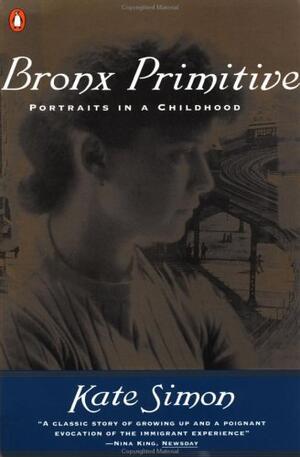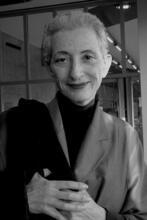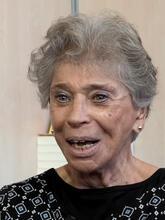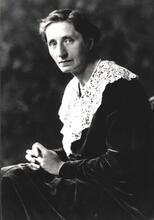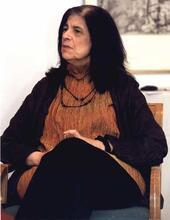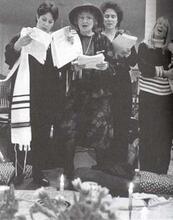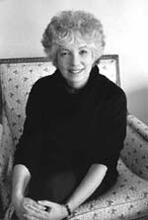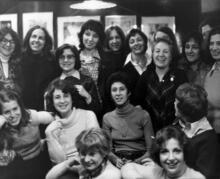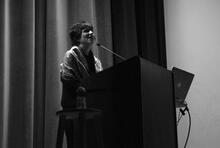Kate Simon
Kate Simon immigrated to the United States at age four and studied English literature at Hunter College. She then married Steve Simon, a deaf endocrinologist. After his death, she married again in 1947, hoping to provide her daughter Lexie with a father. After her daughter’s death, she divorced in 1959. She travelled widely and from 1959 to 1978 wrote a series of guidebooks called Places and Pleasures for Meridian Books. She then wrote her memoirs between 1982 and 1990. The books were shocking for their discussion of her mother’s abortions, her own early experiences of sexual abuse, her political, artistic, and sexual explorations in college, her affairs, and her painful second marriage. But they also showcased an independent woman who spent her life searching for meaning and finding it in the most unlikely places.
Early Life and Autobiographical Works
In the 1980s, Kate Simon published three volumes of memoirs of her remarkable life as an immigrant, Yiddish leftist, bohemian, travel writer, and sexual adventurer. Told from a uniquely ironic and feminist perspective, these volumes together form what Doris Grumbach in the New York Times Book Review called “a classic of autobiography.”
In Bronx Primitive: Portraits of a Childhood (1982), Simon re-creates her girlhood in a Jewish-Italian Bronx neighborhood. Born in Warsaw in 1912 to Lonia (Babicz), a corset maker, and David Grobsmith, a cobbler, she was named Kaila after her maternal grandmother. When Simon was four, she, her mother, and her younger brother journeyed to America, her father having gone to prepare the way three years earlier. Her childhood memories focus on her struggles against her father, who pressured her to practice the piano for hours a day, urging her to quit school and fulfill his own ambitions of becoming a concert pianist. She also records her initiation into sexuality: her traumatic initial reaction to her sister Sylvia’s birth, her thrill at the onset of menstruation, her dawning awareness of sex, her mother’s thirteen abortions, and her resourcefulness in the face of sexual abuse at the hands of two cousins, as well as her barber, the neighborhood pedophile and one of her father’s close friends. Suspecting her father’s tacit complicity with the abusive incidents, Simon spent more and more time away from her parents’ apartment.
In A Wider World: Portraits of an Adolescence (1986), Simon continues to gain independence from her family. Against her father’s will, she switched from vocational school to James Monroe High School, where she studied English literature. On a vacation at a Yiddish leftist encampment in the Catskills with her mother and siblings, she met the Bergsons, who served as surrogate parents for her and for whose children she served as nanny. During the school year, she began to live in various friends’ homes and took odd jobs to support herself. An English teacher at Monroe introduced her to opera, Russian films, and the “free love” community. Graduating and finding her own apartment, Simon became an English major at Hunter College. Her time at Hunter consisted of experiments in bohemian fashions, sisterhood with other Hunter girls, leftist political causes such as the Spanish Civil War, poetry readings, exploratory trips to Harlem, and sexual experimentation. While cohabiting with a lover (much to her father’s chagrin), she became pregnant by another man and had her first of three abortions.
While the first two volumes of memoirs are cautiously optimistic, the final volume, Etchings in an Hourglass (1990), is filled with bitterness and frustration. Simon repeatedly describes God as “the Great Joker” with a malicious sense of humor. Her bitterness is due to the deaths—all from brain tumors—of her first husband, Steve, a deaf endocrinologist whom she had met at Hunter; their daughter, Lexie; and her younger sister, Sylvia. The depression into which these deaths send her is not alleviated by an affair between 1941 and 1946 with a married man, or by a loveless marriage in 1947 to a businessman she hopes will serve as a father figure for Lexie. The marriage would drag on for thirteen years, until their divorce in 1959.
Travel Writing and Legacy
By the end of the 1950s, Simon had already traveled widely. She wrote occasional articles about these experiences, but her career as a travel writer began in earnest in 1958 when a publisher from Meridian Books offered her an advance to write a guidebook of New York City. Between 1959 and 1978, she produced guidebooks for New York, Mexico, Paris, London, and Italy in a series called Places and Pleasures. Noted for their vivid descriptions of destinations beyond the usual tourist haunts, the New York and Mexico guides expanded through four editions each. Simon traveled for the rest of her life, stopping for brief annual stints in New York. She recalls her wide acquaintance and adventures (often sexual in nature) in Israel, the Soviet Union, Yugoslavia, Haiti, St. Dominique, India, Tanzania, Tunis, China, Spain, and Japan. She cultivated a broad spectrum of cross-cultural experiences until her death in New York in 1990.
Spanning the twentieth century, Kate Simon’s memoirs are the records of a lifetime devoted to migration. The themes of her work—a young woman’s search for independence and selfhood, her discovery and attitudes toward sexuality, her loving and ironic stance toward the secular Jewish left, and her encounters with a wide array of “places and pleasures”—make hers a unique voice among memoirists and Jewish immigrant writers.
Selected Works by Kate Simon
Bronx Primitive: Portraits of a Childhood (1982).
England’s Green and Pleasant Land (1974).
Etchings in an Hourglass (1990).
Fifth Avenue: A Very Social History (1978).
Italy: The Places in Between (1970).
London: Places and Pleasures (1968).
Mexico: Places and Pleasures (1963).
New York. Photographs by Andreas Feininger (1964).
New York: Places and Pleasures (1959).
Paris: Places and Pleasures (1967).
A Renaissance Tapestry: The Gonzaga of Mantua (1988).
Rome: Places and Pleasures (1972).
A Wider World: Portraits of an Adolescence (1986).
Grumbach, Doris. Review of Etchings in an Hourglass, by Kate Simon. NYTimes, August 19, 1990, sec. 7.
Neuman, Shirley. “‘An Appearance Walking in a Forest the Sexes Burn’: Autobiography and the Construction of the Feminine Body.” Signature: A Journal of Theory and Canadian Literature 2 (1989): 1–26.
Phillips, Mark. Review of A Renaissance Tapestry, by Kate Simon. NYTimes, April 10, 1988, sec. 7, and Review of A Wider World, by Kate Simon. NYTimes, February 23, 1986, sec. 7.

